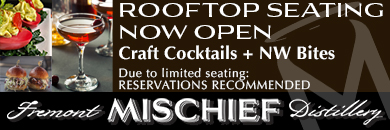The Seattle Public Library (SPL) Special Collections has digitized images from its archives, under the ‘Neighborhood History Project.’ Some of the images appear here, with links to the Special Collections pages that contain more information on each image.
Fremont Branch Of The SPL
The Fremont Branch of the Seattle Public Library was built in 1921, thanks to a $35,000 donation from Andrew Carnegie, $3,000 from the City of Seattle, and $7,000 raised by the neighborhood through a varied collection of fundraisers.

(More info on this photo at http://cdm16118.contentdm.oclc.org/cdm/ref/collection/p15015coll4/id/1354)
With funds short, the City Architect, Daniel R. Huntington, came recommended as the cheapest option. He chose a Mission Revival style for the building, which includes gable and hip roofs, clay roof tiles and stucco cladding, ornamental metal and arched openings.

The building is listed on the National Register of Historic Places and named a landmark building by Seattle’s Landmarks Preservation Board.

(More info on this photo at http://cdm16118.contentdm.oclc.org/cdm/ref/collection/p15015coll4/id/1653)
Over the years, the branch was remodeled several times, including work in 1945 that converted part of the lower level to accommodate material for the Library for the Blind.

(More info on this photo at http://cdm16118.contentdm.oclc.org/cdm/ref/collection/p15015coll4/id/2058)
Prior to the opening of the Fremont Branch Library, the neighbors formed their own library. It is likely more than one small libraries operated in the area – including in the neighboring community of Ross. With volunteer librarians, and donated materials, libraries still provided a vital service to the neighbors.

(More info on this photo at http://cdm16118.contentdm.oclc.org/cdm/ref/collection/p15015coll4/id/1287)
Climbing The Hill
As land developers cleared and prepared properties around Seattle for building, and built houses for sale, they also often built rail lines, street car lines and set up water craft to transport potential purchasers to the sites.

(More info on this photo at http://cdm16118.contentdm.oclc.org/cdm/ref/collection/p15015coll4/id/1784)
One street car (active 1890 – 1897,) ran up and down Fremont Avenue, to carry riders to vast pleasure grounds at the top of the hill above Fremont. The property, owned by Guy Phinney (1852 – 1893,) contained an elaborate garden done in the English style. The grounds were called ‘Woodland Park’.

(More info on this photo at http://cdm16118.contentdm.oclc.org/cdm/ref/collection/p15015coll4/id/1785)
Residential Properties
Occasionally, even Fremont gets snow. The Seattle Public Library provides a photo of Fremont – taken from Queen Anne Hill – of what appears to be a pristine blanket of snow covering the entire community.

(More info on this photo at http://cdm16118.contentdm.oclc.org/cdm/ref/collection/p15015coll4/id/1677)
It can be hard to believe that Fremont – a very urban neighborhood with an industrial and commercial district, and a significant amount of multi-family housing (apartments & condominiums) – once had farmland and livestock surrounding each home. The community in 1898 had a number of homesteads crop up…after the land had been cleared of timber.

(More info on this photo at http://cdm16118.contentdm.oclc.org/cdm/ref/collection/p15015coll4/id/1714)
The homes weren’t that large by standards of the East Coast, but they were larger than the ‘mill houses’ (houses built by the mill workers) that came to Fremont later. Still, these houses contained a family with many children, plus relatives, who all worked the land.

(More info on this photo at http://cdm16118.contentdm.oclc.org/cdm/ref/collection/p15015coll4/id/1713)
A Familiar Landmark
The northeast corner of Fremont Avenue (once Lake Avenue) and Ewing Avenue (now North 34th St), has often been significant in Fremont history – with a central business located there. Shorey House sat at this corner at the end of the 1800s, but by 1901, it had transformed into The Hotel Dixon. A photo from the SPL Special Collections shows bicycles parked in front and on the wide porch. These modes of transportation would be soon supplanted by the automobile. The first one car came to Seattle in 1900.

This building sat at the natural elevation, but with the arrival of the Fremont Bridge, the roadway was raised. For more information about the masonry building eventually built on this site, read the Fremocentrist.com ‘Meet the McKenzie Building’ column from July 2010.
For more information about these images, and The Seattle Public Library’s Neighborhood History Project, visit the project webpage at http://www.spl.org/neighborhoodhistory.
©2013 Kirby Lindsay. This column is protected by intellectual property laws, including U.S. copyright laws. Reproduction, adaptation or distribution without permission is prohibited.

